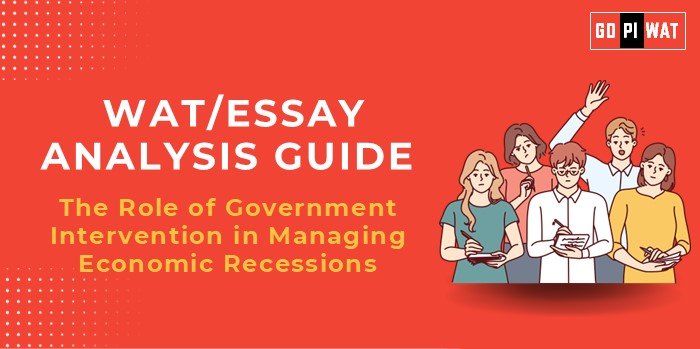📋 WAT/Essay Analysis Guide
📉 Topic: The Role of Government Intervention in Managing Economic Recessions
🌍 Understanding the Importance
Government intervention in economic recessions is critical to ensuring stability, preventing prolonged downturns, and fostering recovery. This theme highlights the importance of fiscal and monetary policy and is central to evaluating critical thinking in economic contexts.
🕒 Effective Planning and Writing
- Time Allocation:
- Planning: 5 minutes
- Writing: 20 minutes
- Review: 5 minutes
- Structure:
- Introduction: 70 words
- Body: 360 words
- Conclusion: 70 words
✍️ Introduction Techniques
- Contrast Approach: “While government interventions have rescued economies from collapse, they also risk creating unsustainable debt burdens.”
- Timeline Approach: “From Roosevelt’s New Deal in the 1930s to India’s PMGKY in 2020, government interventions have played pivotal roles in managing economic crises.”
📑 Structuring the Essay Body
- Achievements: Provide evidence of successful interventions (e.g., TARP, PMGKY).
- Challenges: Discuss issues like debt and implementation delays with comparative insights.
- Future Outlook: Highlight opportunities for improving intervention strategies.
📊 Concluding Effectively
- Balanced Conclusion: “Government intervention is indispensable but requires innovation and accountability to ensure equitable and sustainable recovery.”
- Global Perspective Conclusion: “Lessons from Japan and the USA show that proactive yet prudent policies can navigate recessions effectively.”
✨ Key Achievements and Shortcomings
- Achievements: Avoidance of financial collapse, social safety nets, and public-private partnerships.
- Challenges: Rising inequality, debt burdens, and inflationary risks.
📈 Recommendations
- Promote green and digital economy investments.
- Strengthen global collaboration on economic policies.
- Develop metrics to evaluate intervention effectiveness.
📝 Sample Short Essays
- Balanced Perspective: “Government interventions stabilize economies but must address inequalities and fiscal prudence challenges.”
- Solution-Oriented: “Green investments and efficient stimulus measures are key to sustainable recovery.”
- Global Comparison: “Learning from global examples like TARP and Japan’s liquidity trap can refine intervention approaches.”


